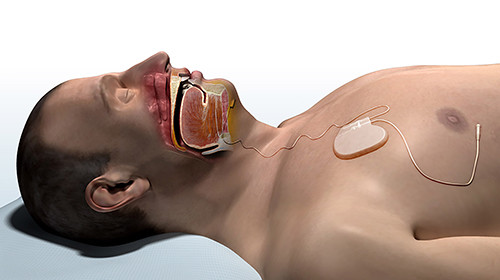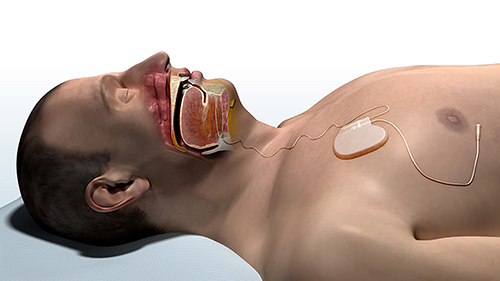
State-of-the-art Hypoglossal Nerve Stimulation Therapy Offers Option to Traditional Treatment for Obstructive Sleep Apnea
As many as 50% of patients with obstructive sleep apnea (OSA) are unable or unwilling to adhere to ongoing continuous positive airway pressure (CPAP) therapy prescribed for the condition, reports David L. Steward, MD, Professor of Otolaryngology at the University of Cincinnati. Of the available alternative solutions, including oral devices and pharyngeal surgery, none is widely effective. Hypoglossal nerve stimulation therapy is a recently-approved procedure for CPAP refractory patients, which uses surgical implantation of a pacemaker-like device to stimulate the upper airway via the hypoglossal nerve and improve OSA.

Hypoglossal Nerve Stimulation Therapy. Source: Inspire Medical
Steward describes how the procedure addresses the primary physiological challenge of OSA, the tongue collapsing during sleep and impeding airflow: “The neurostimulator delivers electrical stimulating pulses to the hypoglossal, or twelfth cranial, nerve through the stimulation lead, and the stimulating pulses are synchronized with ventilation detected by the sensing lead. These pulses stimulate the hypoglossal nerve to move the tongue forward.” Currently, the procedure is commercially available only at select high-volume centers, with approval having come after the publication of results from the Stimulation Therapy for Apnea Reduction (STAR) trial in the New England Journal of Medicine, which Steward co-authored.1 In that study, two-thirds of participants responded favorably to the treatment, an improvement on the generally-accepted 50% of patients who benefit from pharyngeal surgery. A follow-up study of 111 of the 126 original participants showed continued efficacy for 80% of patients after 30 months, and additional long-term studies are underway.
Physicians at the University of Cincinnati Medical Center also utilize drug-induced sleep endoscopy to evaluate the pattern of throat collapse in potential candidates, excluding those who display a circumferential pattern of collapse while including those with an anterior/posterior collapse pattern, since the hypoglossal nerve stimulator is designed to move the tongue forward during sleep. However, the role of drug-induced sleep endoscopy in suggesting a method of OSA treatment is still evolving.
Steward was a lead investigator of the STAR trial, participating in the study design and planning for the trial. Steward views hypoglossal nerve stimulation as an exciting new development in the treatment of OSA, especially given the fact that traditional pharyngeal surgery is associated with a high degree of postoperative pain and swallowing difficulty for several weeks after the procedure. Not only is hypoglossal nerve stimulation associated with better outcomes than surgical uvulopalatopharyngoplasty, early postoperative morbidity has been seen to be significantly reduced as well. For OSA patients who cannot or do not adhere to CPAP therapy, hypoglossal nerve stimulation may be a useful alternative.
David L. Steward, MD
Professor of Otolaryngology, University of Cincinnati Medical Center
Director, Clinical Research Program
Co-Director, Resident Research Program, UC Department Otolaryngology-Head and
Neck Surgery
University of Cincinnati College of Medicine
(513) 558-4199
stewarddl@ucmail.uc.edu
Leave a reply →

